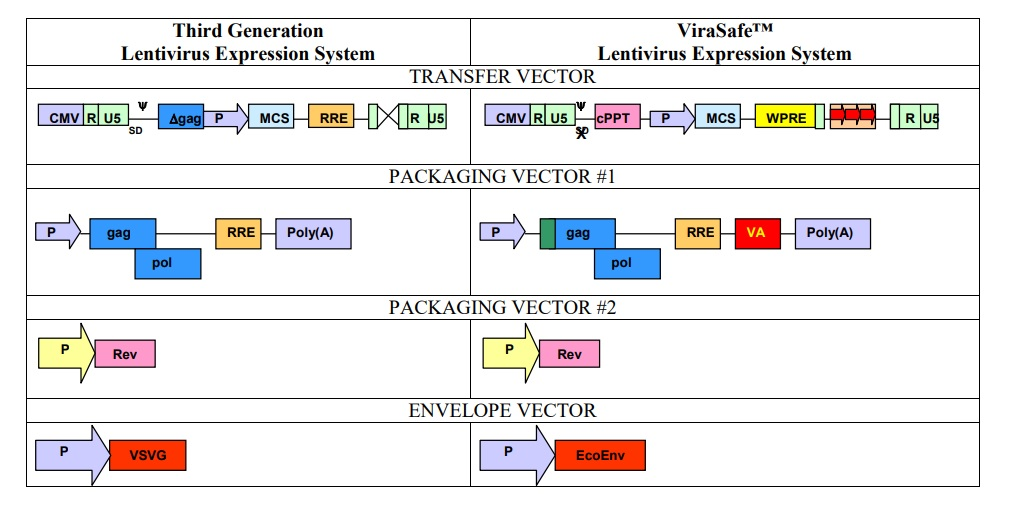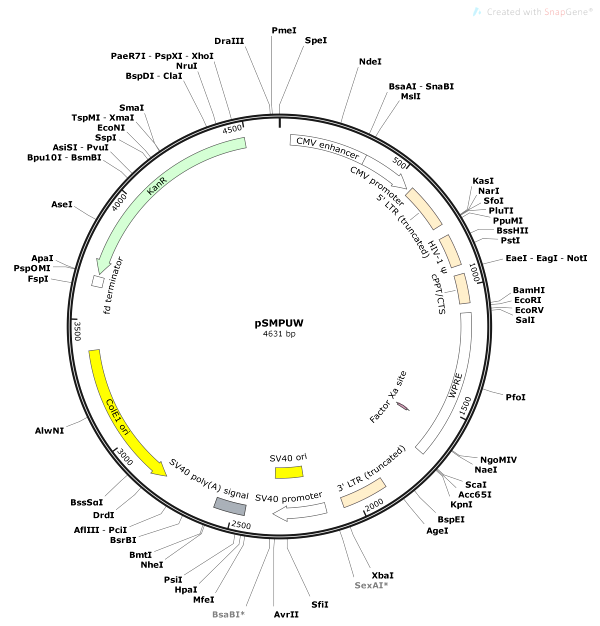Lentiviral Expression
Julian PampelLentiviral vectors based on the human immunodeficiency virus-1 (HIV-1) have become a promising vector for gene transfer studies. Lentivirus particles are produced from 293T cells through transient transfection of plasmids that encode for the components of the virion. Recent lentiviral packaging systems have separated the viral components into 3 or 4 plasmids to prevent unwanted infection. They are a sub-class of retroviruses that can be used for both transient and stable gene expression.
Unlike retroviral vectors they can infect both proliferating and non-proliferating cells. Lentiviral vectors have been shown to deliver genes to neurons, lymphocytes and macrophages, cell types that previous retrovirus vectors could not be used. Lentiviral vectors have also proven to be effective in transducing brain, liver, muscle, and retina in vivo without toxicity or immune responses. Recently, the lentivirus system is widely used to integrate siRNA efficiently in a wide variety of cell lines and primary cells both in vitro and in vivo.
Lentiviral particle production

LTV Cell Line
The 293LTV cell line is a permanent cell line derived from HEK293T and was selected to have a high lentiviral yield. This cell line is fast growing and has a firm attachment to the culture plate, which can sometimes be problematic with standard 293T cells.
Lentiviral expression vector
Cell Biolabs lentiviral expression systems vary by the structure of the expression vector in particular different possibilities of selection marker like IRES, Neomycin, Hygromycin, Blasticidin and Puromycin. Bicistronic Expression Vectors contain two different marker generally one of them is IRES. Kanamycin is used as resistance gene for all vectors. EF-1 ist the promoter in all variants. The expression vectors are designed to accommodate large inserts of 7-8 kb with the ecxeption of the promoterless vector varaint which is able to accommodate up to 10 kb. As the name already says it lacks any promoter ahead of the multiple cloning sites, nor does it contain any reporter genes (fig.1). This allows you to introduce your own promoter, marker or reporter that is optimal for your gene of interest or target cell.
All vector backbones with extensive information and sequence download available in FASTA format are accessible via the product page. You can find all of Cell Biolabs expression vectors down below!
Although the lentiviral expression systems are designed to work with any 2nd or 3rd generation lentiviral packaging system they are developed for best results in combination with the ViraSafe™ Lentiviral Packaging Systems which benefit from gene-specific promoters - simply clone the promoter and gene of interest together into the vector.
Lentiviral Packaging Systems
Cell Biolabs offers two different variants of lentiviral expression systems. Both show significantly reduced homology compared to other 3rd generation expression systems for added safety. Vectors provided individually to allow optimization of vector ratio.
The Ecotropic Lentiviral Expression Systems contain an expression vector plus three packaging plasmids (Rev, gag-pol, and envelope) necessary to make recombinant lentivirus. Pantropic lentiviruses contain three packaging plasmids (Rev, gag-pol, and VSVG) for use with your own third generation lentiviral transfer vector. As they are VSVG-pseudotyped they are able to infect cells of virtually any species, since infection is not receptor mediated.
If you also need a lentiviral expression vector, consider one of Cell Biolabs Lentiviral Expression Complete Systems which contain everything provided in the packaging systems plus your choice of 11 different expression vectors.
Lentivirus Expression Complete Systems

The ViraSafe™ Lentivirus Expression Complete Systems is a safer alternative compared to other 3rd generation expression systems. The overlap with native HIV genes has been reduced much further which lowers the chance of generating replication-competent virus. Levels of lentiviral titers are still similar to other third generation systems.
Removal of Gag sequence and Rev-Responsive Element and addition of Codon Wobble to the packaging Vector #1 (fig.:2, green) reduces sequence homologies. Together with the Hybrid 3’ LTR Poly(A) tail which prevents sequence read-through transcription, all 3 elements increase the safety of the system. In addition the Poly(A) tail stabilizes the vector transcript in packaging cells – with WRPE and by incorporating adenovirus VAI element the viral titer is increased. All vectors including packaging vectors are provided separately to allow end-user to optimize the vector ratio for maximal lentivirus production. All ViraSafe Expression Systems contain a cloning/expression vector, a LacZ control vector, and three packaging vectors.
Lentiviral Control Plasmids and Premade Controls
Co-transfect one of these plasmids with a lentiviral packaging system to create a recombinant lentivirus containing a reporter gene. Cellbiolabs offers control plasmids with GFP, GFP-Puro, LacZ and RFP-Puro as marker. Lentiviral supernatant can be produced by cotransfecting 293T with the control plasmid and a lentivirus packaging mix such as Cell Biolabs’ ViraSafe™ Lentiviral Packaging System. Supernatants can be used directly or purified/concentrated if needed. The resulting transduction control virus can also be used to generate stable cell lines, and stable clones can be selected with the help oft he marker. The controls can also be obtained premade for GFP and RFP.





